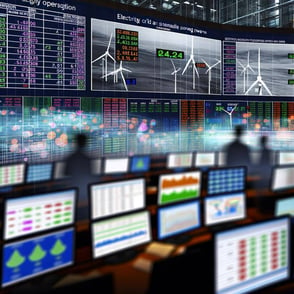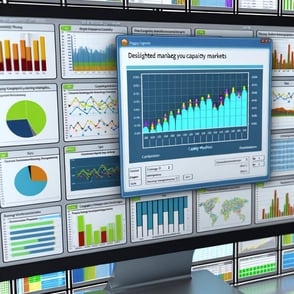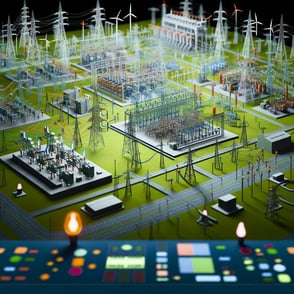Forwards and Futures Market
What are Forwards and Futures Markets?
The forwards and futures markets are essential components of the electricity trading framework, providing mechanisms for market participants to hedge against price volatility and secure stable prices for future delivery of electricity. Unlike short-term markets such as the Day-Ahead, intraday continuous and intraday auction, these markets enable buyers and sellers to lock in prices for a specific quantity of electricity to be delivered at a future date. This mitigates the risks associated with fluctuating energy prices. Electricity in these markets is typically traded between four years and one month before delivery.
The Purpose of Forwards and Futures Markets
The primary purpose of the forwards and futures markets is to offer tools for risk management and price stabilization in the energy sector. These markets allow energy producers, suppliers, large consumers, and traders to hedge against price volatility and ensure predictability in their financial planning. By securing prices in advance, market participants can protect themselves from adverse price movements and plan their operations more effectively.
How the Forwards and Futures Markets Operate
Both forwards and futures contracts are agreements to buy or sell electricity at a predetermined price at a specific future date, but they differ in their standardization and trading venues.
Forwards contracts are typically traded over-the-counter (OTC), meaning they are negotiated directly between two parties. This allows for customization in terms of quantity, delivery period, and other contract specifics, providing flexibility to tailor contracts to the specific needs of the parties involved. However, since forwards are not traded on an exchange, they carry a higher credit risk due to the potential default of either party. Default occurs when a party fails to fulfill its contractual obligations, such as delivering electricity or making payment as agreed.
In contrast, futures contracts are standardized agreements traded on exchanges, such as the European Energy Exchange (EEX). These contracts have predefined terms, such as quantity and delivery period, which enhances their liquidity compared to forwards. Futures can be settled physically, with the actual delivery of electricity, or financially, with cash settlement based on the difference between the contract price and the market price at expiration. To mitigate the risk of default, exchanges require participants to post initial and maintenance margins.

The forwards and futures markets involve a diverse group of participants. Utilities and power companies engage in these markets to hedge against price volatility and secure future supply. Industrial consumers, such as manufacturers, use these markets to manage energy costs and ensure price stability for their operations. Financial institutions, including banks and hedge funds, participate in trading to speculate and provide liquidity, while brokers facilitate trades between buyers and sellers.
Price Formation in the Forwards and Futures Markets
Price formation in the forwards and futures markets is influenced by a variety of factors that drive supply and demand dynamics. The fundamental principle is that prices reflect the balance between supply and demand at any given time. Weather conditions, economic activity, and the availability of renewable resources significantly influence electricity supply and demand. For instance, a cold winter can increase demand for heating, driving up prices, while a windy period can boost supply from wind turbines, potentially lowering prices. Additionally, the regulatory environment, including policies related to carbon emissions, subsidies for renewable energy sources, and energy efficiency measures, impacts the market. Fuel prices also play a crucial role, as the prices of natural gas, coal, and other fuels used for electricity generation directly affect power prices.
Since the contracts involve future delivery, market expectations about upcoming conditions, such as anticipated changes in fuel prices or regulatory policies, also influence current prices. These expectations are often based on economic forecasts, political developments, and technological advancements.
Impact of the Forwards and Futures Markets
The forwards and futures markets are vital to modern energy trading, offering key tools for risk management and price stabilization. By locking in future prices, these markets help energy producers, suppliers, and large consumers mitigate financial risks associated with price volatility, allowing for more predictable and stable operations. This stability is especially beneficial for utilities and power companies managing large-scale energy supplies. The liquidity of futures markets enhances market efficiency by enabling easy entry and exit of positions, ensuring a ready market for buying and selling electricity contracts.
Hedging activities in these markets reduce the impact of price fluctuations, protecting participants from adverse price movements due to unexpected changes in supply and demand dynamics. This risk management is crucial for maintaining financial stability in an industry affected by significant price volatility.
These trading mechanisms also support the integration of renewable energy sources. By hedging prices and securing future contracts, they enhance the financial viability of renewable projects, which encourages investment in sustainable energy solutions. As renewables begin to take up a larger share of the energy mix, the forwards and futures markets will continue to be essential in managing their variability and unpredictability.
Conclusion
The forwards and futures energy markets provide useful tools for risk management and price stabilization. By enabling market participants to secure prices for future delivery, these markets help mitigate financial risks associated with price volatility and contribute to a more stable and efficient energy sector.
As the energy market continues to evolve, the importance of forwards and futures trading will remain, ensuring financial stability and operational predictability.
Glossary
- Forwards Contract: A customized agreement to buy or sell a specific quantity of electricity at a predetermined price on a future date, typically traded OTC.
- Futures Contract: A standardized agreement to buy or sell a specific quantity of electricity at a predetermined price on a future date, traded on an exchange.
- Over-the-Counter (OTC): A decentralized market where contracts are traded directly between parties without the supervision of an exchange.
- Standardization: The process of establishing common contract terms and conditions to facilitate trading on an exchange.
- Hedge: An investment or trade made to reduce the risk of adverse price movements in an asset.
- Margin Requirements: Funds that must be deposited by participants in futures contracts to cover potential losses and ensure contract performance.
- Liquidity: The ease with which an asset can be bought or sold in the market without affecting its price.
- Price Volatility: The degree of variation in the price of an asset over time, often influenced by supply and demand factors.
- Exchange: An organized marketplace where standardized contracts are traded, providing a regulated environment and reducing counterparty risk.
- Balance Responsible Party (BRP): An entity responsible for balancing the electricity supply and demand within a specific portfolio.
- Default: The failure to fulfill contractual obligations, such as delivering electricity or making payments as agreed.
.png?width=200&height=80&name=etpa-logo-color%20(1).png)











.png)
.png)
-1.png?width=250&height=100&name=etpa-logo-color%20(1)-1.png)